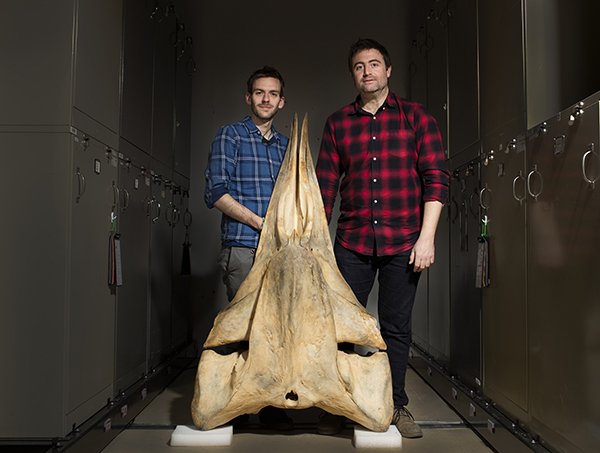Scientist shed new light on the mystery of the pygmy right whale

“THIS IS like finding a fossil kangaroo in Scotland!” says Senior Curator of Vertebrate Palaeontology at Museums Victoria Dr Erich Fitzgerald about the exciting discovery of fossilised earbones belonging to the pygmy right whale off the coasts of Italy and Japan.
Today, this whale is confined to the cooler waters of the Southern Hemisphere where food is abundant, unlike northern waters, which Erich says are like “an oceanic desert” for the species. “Until now, it has been assumed that the pygmy right whale evolved and underwent all of its history in the Southern Hemisphere, never swimming across the equator because of the barrier presented by the desert seas of the equatorial regions,” he says.
Erich describes the pygmy right whale as the ultimate “odd-ball” of whales due to the animal’s controversial taxonomy — still the subject of debate today— and our inability to trace its evolutionary history. “They truly are the most puzzling and mysterious of all living whales. And it is this very mystery surrounding them that makes them so intriguing,” he explains.

Dr Felix Marx and Dr Erich Fitzgerald with pgymy right whale specimen from Museums Victoria’s Collection. (Image Credit: Museums Victoria)
The pygmy right whales evolution
The pygmy right whales mysterious evolution is a result of a lack of clairty surrounding the animals classification. “The placement of the living pygmy right whale in the family tree of whales remains perhaps the greatest controversy in cetacean taxonomy,” Erich says. “The name ‘pygmy right whale’ is a bit misleading because it is not a right whale at all!”
Instead, the genetic makeup of the pygmy right whale demonstrates they’re more closely related to the rorqual whales— a large group of baleen whales. Other taxonomists have queried whether the pygmy right whale is the sole-survivor of a lineage that stretches back to an extinct whale species known as Cetotheres that lived during the Oligocene epoch more than 23 millions years ago.
“Some scientists continue to argue that the pygmy right is exactly that—a miniature member of the right whale family,” Erich says. “In any event, fossils that might clarify the pygmy right whale’s story are as rare as walking whales.”
The impact of global climate change on pygmy right whales
Erich explains that the pygmy right whales prehistoric voyage to the Northern Hemisphere was made possible by the lowering of the warm water barrier at the equator during periods of global cooling. But after the climate began warming, waters in the north became increasingly unsuitable for the whale until eventually they became extinct in these oceans.
Erich says such migratory behaviours have great implications for whales today. “Global warming may lead to some living marine mammal species having to move towards the poles to cooler waters if the tropics become uninhabitable,” he explains. “Under that scenario, the equator would become impassable and populations of widely distributed whale species in the northern and southern hemispheres would not be able to mix.”

An illustration of the pygmy right whale. (Image Credit: carl Buell)
The findings were publiced in the journal Current Biology today.
READ MORE:
- Top 10 whale-watching spots in Australia.
- Why do humpback whales protect other species from attack?
- How do whales learn to sing?
- Swim with the humpback whales of Tonga.




